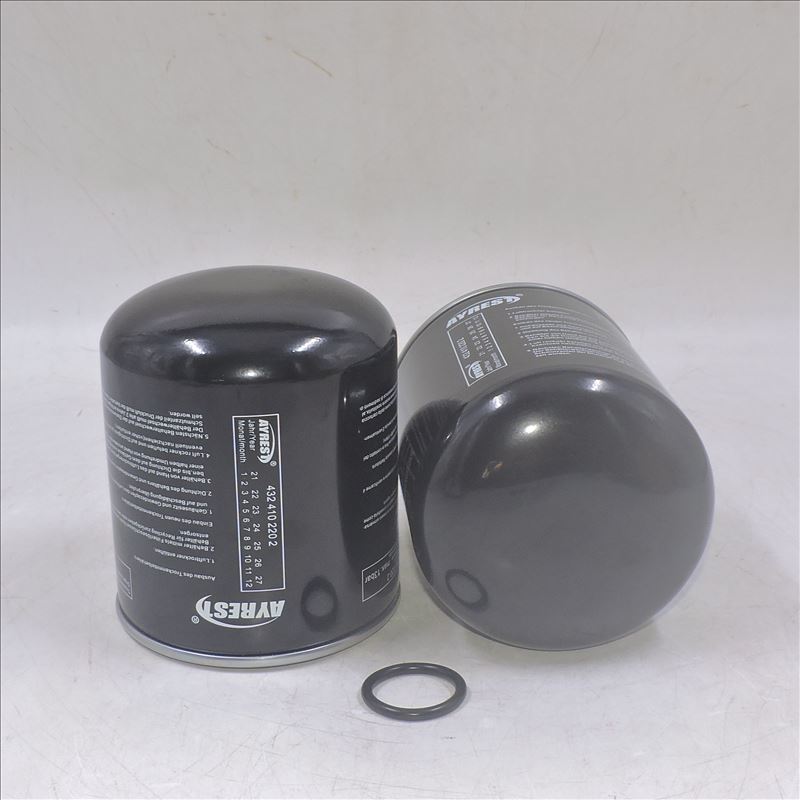Desiccant dryer and filter
WABCO Air Dryer 4324102202 Cross Reference HENGST T390W.MANN TB 1374/7x.MAN 81.52102-0016.
The difference between desiccant dryer and filter

A desiccant dryer and a filter are two different components used in compressed air systems for different purposes.
Desiccant Dryer:
A desiccant dryer is a device specifically designed to remove moisture from compressed air. It utilizes a desiccant material, such as silica gel or activated alumina, to absorb the moisture present in the compressed air. The desiccant material adsorbs the water vapour, reducing the dew point and preventing condensation from occurring downstream. Desiccant dryers are commonly used in applications where low levels of moisture are required, such as in sensitive pneumatic equipment, electronics, or painting processes.
Desiccant dryers can be further classified into two types: heated and heatless.
1.Heated Desiccant Dryer: A heated desiccant dryer uses a combination of adsorption and heat to remove moisture from compressed air. The hot air is passed through one chamber of the desiccant bed to adsorb moisture, while the other chamber regenerates by purging out the captured moisture using a flow of dried compressed air or a separate purge heater. This alternate switching between chambers ensures a continuous supply of dry air.
2.Heatless Desiccant Dryer: A heatless desiccant dryer relies solely on the adsorption capability of the desiccant material to remove moisture. It uses a pair of desiccant-filled chambers, one in adsorption mode while the other is in regeneration mode. The flow of compressed air is redirected between the chambers, allowing one to dry the air while the other is purged to release the captured moisture. This type of dryer does not require any external heat source.
Filter:
A filter in a compressed air system is used to remove various types of contaminants, such as oil, dust, dirt, and particulates, from the compressed air stream. It helps protect downstream equipment from damage, improve the quality of compressed air, and ensure the efficient operation of pneumatic devices. Filters are available in different types, including particulate filters, coalescing filters, and activated carbon filters.
1.Particulate Filter: Particulate filters, also known as pre-filters or general-purpose filters, remove solid particles, dust, and debris larger than the filter's micron rating. They act as the first line of defense in removing coarse particles from the compressed air.
2.Coalescing Filter: Coalescing filters are designed to remove moisture and oil aerosols from the compressed air. They use a combination of filter media and specially treated fibers to capture and coalesce fine water droplets and oil aerosols into larger droplets, which can then be drained or filtered out.
3.Activated Carbon Filter: Activated carbon filters are used to adsorb certain odors, hydrocarbons, and volatile organic compounds (VOCs) present in the compressed air. The activated carbon media has a high adsorption capacity, allowing it to capture and retain these contaminants.
It's important to note that while a filter can remove some moisture and an air dryer can filter out some contaminants, their primary functions are different. An air dryer focuses on moisture removal, while a filter primarily targets the removal of contaminants. Both components may be used together in a compressed air system for comprehensive filtration and drying requirements.
In summary, a desiccant dryer is designed to remove moisture from compressed air using a desiccant material, while a filter is used to remove contaminants such as oil, dust, and particulates. They serve different purposes and can be combined in a compressed air system to achieve dry and clean compressed air.





















